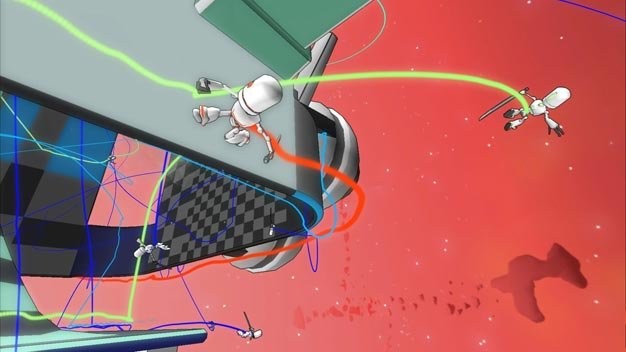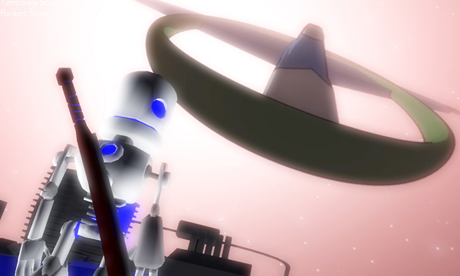I think it’s safe to say that I haven’t played a game like Plain Sight before.
That is a common statement when you’re dealing with independently developed games. Without the constraint of the almighty publisher above your head, pelting you with focus groups and market research, you can develop a game in your ultimate vision. On the flip side of the coin, though, not having big backers also can lead to technical issues or an absence of polish that really ensures your game works, and works well.
Such is the case with Plain Sight. This indie, multiplayer-only romp is a game that is unique in both its art style and its gameplay, offering a lightning-quick melee brawler with Tron-like visuals, but is often hampered by miscommunication and numerous technical issues.
Plain Sight casts you as a mini robot ninja and your objective is to kill the other players to gain energy. Every kill nets you energy which builds up in your body. The catch is, in order to gain points, you have to blow yourself up. This banks the energy you’ve accrued prior to self-destruction. The more energy you have stored, the bigger the explosion, and anyone caught in your blast multiplies your point total. If you are killed any time before you can detonate yourself, however, you lose all your energy. Further complexifying the process, you get bigger and slower as you gain energy, and the game also throws in numerous powerups and things like stealth and fire swords to keep you competitive if other players are dominating.

It’s this interesting risk/reward system that really drew me into the game. Do I keep fighting in my powered-up state, or do I just bank my energy even though my small explosion won’t net me many points? You constantly have to take chances and gambles to stay on top of the scoreboard.
The usual game modes such as Deathmatch and Team Deathmatch are present, but Plain Sight adds a new spin on King of the Hill, where you have to explode on certain areas of the map to claim it, and the only way to steal it is to make a bigger explosion at that location. The mode that kept me coming back, though, was Ninja! Ninja! Botzilla! Here, a team of regular-sized robots must take on a towering bot who wears a toy Godzilla hat. The towering player can take several hits, and it’s up to the team of small soldiers to take him down. After the deed is done, a new player takes the spot of Botzilla. It was the most fun and had players on my team coordinating to take down the Botzilla player without being seen or destroyed.
The gameplay that results from Plain Sight‘s points system is as hectic as exploding robots sounds. Players are constantly flying around the maps, which are 360-degree planetoids of sorts, and you can easily be caught off guard flying through the air to the next part of the map. Attacking is executed by locking on to an opponent and charging your dash move. The longer you charge, the more accurate and powerful your attack is, but you leave yourself open to attack as you stalk your prey. You’re not totally defenseless, though. If you dash attack back at your attacker, you can repel the attack and live to fight another day. It’s an exciting way to keep you constantly engaged and aware of your surroundings.
Of course, it wouldn’t be a worthwhile PC multiplayer title without an upgrade system. In Plain Sight, the banked energy you gain is converted to points that you use to buy upgrades between deaths. You can upgrade abilities like your dash charge speed, attack power, and jump ability. You can also buy new abilities like putting a shield up, Smash Bros. style. The system can change your bot’s playing style, one example being a player I encountered who would sneak around the arena and stealthily kill people by maximizing his run, jump, and dash speed stats.

On the visual side, the game combines steampunk visuals and monochrome level aesthetics colored by the players’ Tron-like light streaks. Each robot emits a trail of light with a different color, and as everyone flies around and repels off of one another, the grayscale level is decoratedby the streaks. The robots look like little steampunk creations, and the soundtrack, while it tries to match that motif, mostly comes off as a 1920s jazz wannabe. It’s not horrible, but I found myself turning it down more often than wanting to listen.
The main problem with Plain Sight, though, is that the game does not effectively communicate its feature set or how to play the game. There is an in-game tutorial, but it only covers the basics and never dives into any of the advanced techniques or what the powerups do. It assumes you’ll learn through death, defeat, and experimentation, but that is a flawed system. It’s bad when I’m basically told to go into the practice mode and figure it out myself. It can be frustrating for new players, something numerous people have expressed in the in-game chat; Beatnik Games should have implemented a few more tutorials or guidance to ease people into the hectic experience.
That is assuming that those people could even log in. At launch, my ability to log in to the game is spotty. The game would sometimes tell me it could not contact the server, or even that my CD key was invalid or already used. Servers would not populate well or would take too long to refresh. Exiting the game and restarting it usually fixed the problem, but players shouldn’t have to do this to enjoy the game. The developer is releasing patches that fix these issues and add a few maps, but at the time of this writing, the malfunctions still exist.
Plain Sight is truly a unique and enjoyable game. An interesting risk/reward system that permeates all facets of the gameplay breeds hectic, brawl-happy fun. If Beatnik Games could polish the game through patches and make the front-end experience better, Plain Sight would approach must-buy status. As of now, though, the muddled tutorial and technical issues make for a less-than-stellar experience.

















